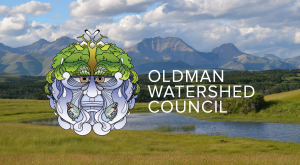Oldman Watershed Council discusses water, drought, conservation
By Rob Vogt
The Oldman Watershed Council is a not-for-profit organization that is working in partnership with communities and residents to improve the Oldman River Watershed. The council consists of members who live or work within the Oldman basin. These members provide leadership and guidance in watershed planning and management, water quality monitoring, and stewardship promotion.
At a drought preparedness and mitigation forum hosted by the Chinook Watershed Crew at the Claresholm Community Centre on April 15, representatives of the Oldman Watershed Council explained what they do and how to conserve water.
Shannon Frank, the council’s executive director, discussed what her organization does.
“We don’t take sides on issues but we don’t remain silent,” she said, adding they provide information.
Frank noted approximately 90 percent of water in the Oldman River comes from headwaters.
“The health of our rivers has declined over time,” she said, noting that is due to altered landscapes.
Frank pointed out the allocation of water in the area goes 83 per cent to irrigation, and about one per cent for municipal use.
Currently, the Oldman River is 37 percent of average stream flow; 32 percent of full capacity for the Oldman reservoir; and 22 percent of full for the St. Mary’s reservoir.
The watershed council works at restoring natural infrastructure, with ecosystem services aimed to increase drought resilience; reduce heat domes; increase flood protection; and water filtration.
In total, the council has planted 21,000 willows and other trees along waterways; built 60 kilometres of fencing along waterways; kept 11,000 livestock out of waterways; and created 30 off-stream water projects.
Emily Purvis, the council’s restoration manager, then discussed conserving water in drought.
“People of the prairies use a lot of water,” she said, citing Lethbridge as an example where 232 litres per person per day are used.
Purvis said there are five stages to conserving water: understanding water use; checking for leaks; doing all low-effort, zero-cost strategies; reviewing all high-impact strategies; and making your yard smart.
She then turned her attention to outdoor water conservation.
Purvis suggested xeriscaping in the backyard, which is the process of landscaping, or gardening, that reduces or eliminates the need for irrigation.
“Let the native plants do the work,” she said.
Xeriscaping benefits include needing less water; attracting pollinators and increasing biodiversity; having less pesticides, fertilizers and chemicals in the waterways; spending less time on maintenance; and showcasing flowers and plants that grow naturally.
The principles of xeriscaping include planning and design; improving the soil; creating practical turf areas; watering efficiently; selecting the appropriate plants and grouping them; and using mulch.
Lawns use a lot of water, and Purvis listed some alternatives to lawn, including clover; creeping thyme; and a grass-seed mix.
She also discussed tree care including where to water; watering the whole tree; understanding the top 12 inches are moist after irrigating; and considering trees instead of lawn.
Purvis also discussed conserving water in the home with suggestions such as putting full loads in the washer and dishwasher; adopting low toilet flows; using milk jugs to collect water when running water to make it cold; and other measures.
The drought preparedness and mitigation forum also included a showing of the video “Dried Up: What now?”; a panel discussion of experts; and 14 information booths.

